Author’s Note: “A Day in the Life” is a series in which we chronicle a specific day in the life of a long-term traveler. We highlighted this particular story about camping in the Sahara and attending a very local festival in a country like Tunisia because having this type of experience is very difficult when you’re only taking a one-week vacation. Long-term travel allows you to stay put sometimes and gives you the opportunity to really dig in to the local culture and participate in a festival like the Miller family did in the story below.
Whoever idealized the serene night scene of Berber tents surrounding an oasis, fires flickering, a reflection of the stars above, the quiet hum of insects, and maybe a Bedouin maiden bathing by moonlight has obviously NOT actually spent a night on those sands… especially on a festival night.
If there is one thing that an oasis night is not, under any circumstances, it is quiet. There is really no way to describe the cacophony of sounds that paint the darkness: donkeys braying, dogs barking, cats calling, camels roaring (they don’t exactly roar, but they are certainly making their best attempt.) Add to that the clip clop of horse hooves, followed closely by the squeak of the wheels of the cart it is pulling, the low level drone of Arabic, whispers, conversations, laughter, shouting, and singing, and it is a symphony that echoes out onto the desert and disappears into the darkness.
The drumming started just at bedtime. BOM-bah-bah-bah-BOM-bah-bah-bah-BOM-BOM-BOM-bah-bah-bah….
The constant rhythm of skin drums beaten with smooth sticks by men in ankle length, hot pink robes, and green vests. Their red hats hung with long black tassels, reminiscent of a horse’s tail attached at the center.
The high, shrill trilling of the Bedouin women accompanying their beat: “HIEEEELA-la-la-la-la-la-la-la-la-LA!” BOM-bah-bah-bah-BOM-bah-bah-bah….
There is no sense in putting in earplugs and trying to sleep. The only thing to do is lay awake in the deep dark and frosty cold of the desert night and enjoy the symphony, trying to burn it into my sound memory for the deep dark and frosty cold of my ancient days, sixty years from now.
Sometime after midnight, as suddenly as if a switch had been thrown: quiet.
No more drums, no more people sounds, only the lonely donkey’s cry or dog’s bark. We emerged from the tent to listen, our breath hanging in the frosty air. Desert nights, especially in winter, hover around the freezing point. It was impossible to rush (as my chilly self wanted to do) across the sand to the bathhouse. We had to stand, heads held aloft, and look at the stars.
It was hard to believe that these are the same stars that watch over us in the pine forests of northern New England, but they are. The stars of the northern hemisphere: Ursa Major and Minor, the Pleiades, and Orion; standing like an Arab warrior over the ocean of sand. The moon was no where to be seen, hidden among the date palms at the edge of the horizon, perhaps, but the stars more than made up for its light. The desert stars alone were worth the trip.
Between drumming and the dawn prayers came three or so hours of twilight sleep. Douz has at least four mosques, each of which seems to pride itself on the accuracy of timing their morning prayers, and they certainly do not agree. The first wail arose at five thirty, sharp, and it was nearly half an hour before the last song faded into the semi-darkness.
The sound of the muezzin is an effective alarm clock and reminds even we infidels to begin the day by addressing the Universe, although we do it from inside our warm sleeping bags. It would be another three hours before it was warm enough to emerge from our green tents, blow on our frozen fingers, and start the fires resulting in coffee and tea while Gramps hummed the inevitable under his breath: “Midnight at the Oasis” by Maria Maldaur (1973).
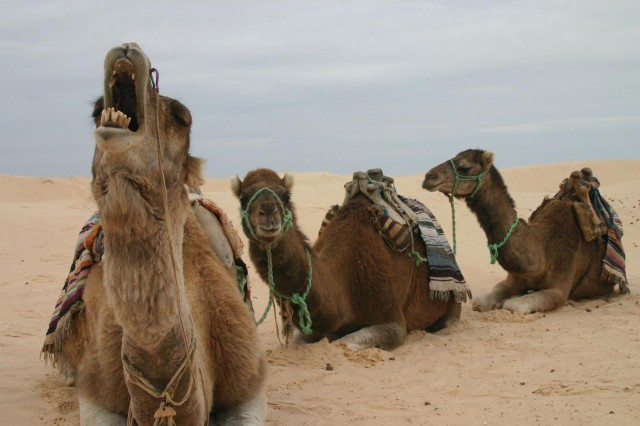
The 41st official celebration of the Festival du Sahara marks a celebration that has been going on for much longer. The festival grew out of a Bedouin marriage and camel market. Each year the nomadic peoples of the Sahara would come together to buy wives for their sons, trade camels and other goods, and celebrate with camel races, horse races, hunts with their dogs, and nights full of music and dancing. It causes the population of the sleepy oasis town of Douz to swell from around 12,000 to several times that number as people from all over North Africa make their annual pilgrimage to party. We were surprised to find just a handful of other westerners in attendance,owing, likely, to the difficulty in acquiring any details, such as the actual dates, which aren’t available until the last minute.
By the time we’d walked the long and winding path through the date palms, there were no seats left on the risers, built facing the Grand Erg Oriental. It took us a while to find a spot, way down at the end, where there was still standing room and where the kids could worm their way to the front and sit just beyond the make shift fence, actually inside the arena, and build sand castles with the other little kids while they waited and watched.
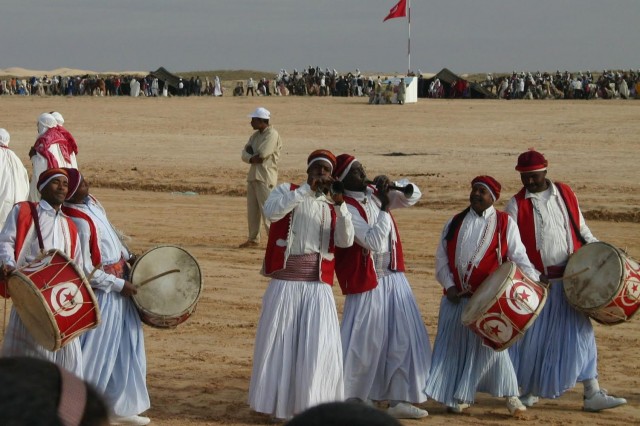
The crowd erupted as a huge painting of President Ben Ali was solemnly paraded past the risers, and the Tunisian anthem was played while the flag was raised. Then, the drumbeat commenced, a long line of drummers, dancers and Bedouins winding across the sand from their semi-circular ring of wool tents toward the watching crowd. The opening parade of camels and horses and veiled women dancing to the beat of the ever-present percussion took my breath away, but was nothing compared with the rest of the festivities.
My children cheered along in English as the camel racers galloped past, beating their mounts with what looked like twists of wire. The crowd roared with mirth as one racer tumbled off of her perch and the camel looked back with disdain, kicking sand in her face. We all laughed and shouted as the fighting camels (baited and goaded on by their Bedouin masters) ran from the ring, bellowing: the following camel racing, and snapping his teeth, trying to bite the bottom of the winner. They raced off into the dunes with their master huffing and waving their hands as they chased their animals across the sand.
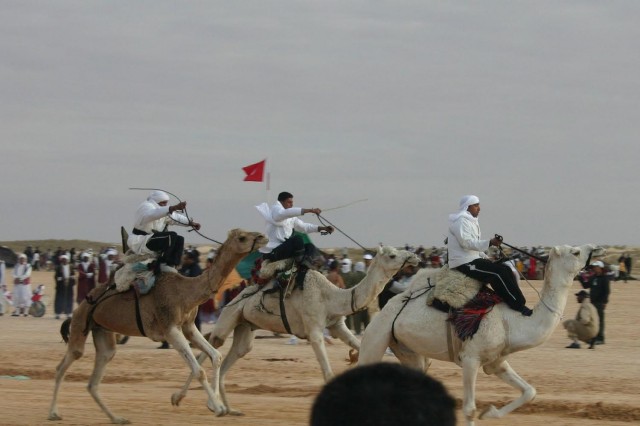
The local crowd favored, by far, the hunt. Long, sleek, sandy grey colored dogs were turned loose after numerous rabbits and two, big eared, desert foxes. The crowd went wild as the quarry ran and the canine predators followed in hot pursuit. There was unanimous applause as one dog finally snapped the neck of the rabbit. The fox received a standing ovation when he turned and bit the dog on the nose, sending his pursuer limping away. I hoped he’d won and would get to sneak out between the tents and back to his hole in the sand. No such luck. The dog, having given up the chase, was replaced by a team of stickball players who pummeled the little fox to death and then held him up by the tail for the cheering crowd. Elisha emerged from his ringside seat about this time, having snaked his way back through the crowd.
“This makes me sad, Mama.” he said, as he buried his face in my skirt.
“Me, too.”
Anything you’ve ever seen in a movie about Arab horsemen does not hold a candle to the real thing, I promise you. They are a culture of riders generations deep, so accomplished that even the little children took my breath away.
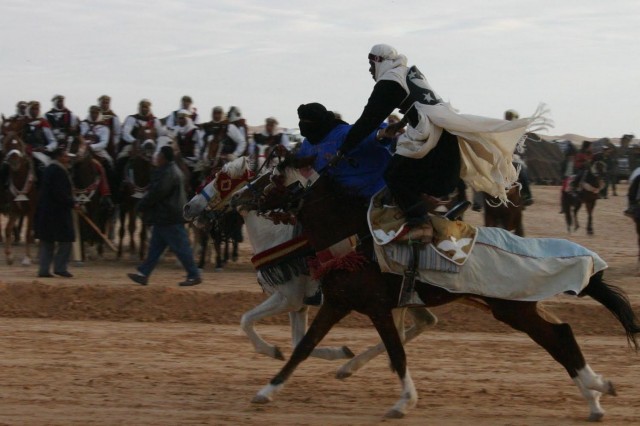
Racing back and forth on their decorated mounts, sitting, standing, frontwards, backwards, feet in the air while hanging on to their horse’s neck, stacked two high, three people balanced between two horses, firing guns, tossing sabers, swinging from side to side, touching their feet to the ground on either side of the horse as the crowd became a living thing.
Little children were heartily tossed by an arm and a leg, from safety on the sand, up to their fathers on horseback as they tore by at break-neck speed. Little ones climbing up to stand on trusted shoulders, or swing from side to side, or hang upside down off of the back of the horse before being thrown again, off of the back of a galloping horse. Caught in mid air by an uncle.
Manes and tails dripping with fringe and satin flags stretched out behind the flying horses from beneath their saddles. Men wrapped in turbans of every color, peering out from between the folds with charcoal eyes, were the heroes of the hour as their robes billowed around them, and they performed the very best of what has, no doubt, been handed down from father to son through countless ages.
What, then, could I say, when one such rider trotted up on his wet and dripping mount, his skin as black as the desert night, studded with beads of sweat like stars, his beautiful head wrapped in a turban, his chest bound in leather armor, and extended his hand with a smile?
“Will you ride with me on the Sahara?” He asked, in Arabic scented French, his eyes dancing.
What’s a fair maiden to say to such a knight? Weak in the knees, I grasped his warm hand and allowed myself to be swung up behind his saddle. Without a word he wheeled his horse and we galloped off into the desert sunset.
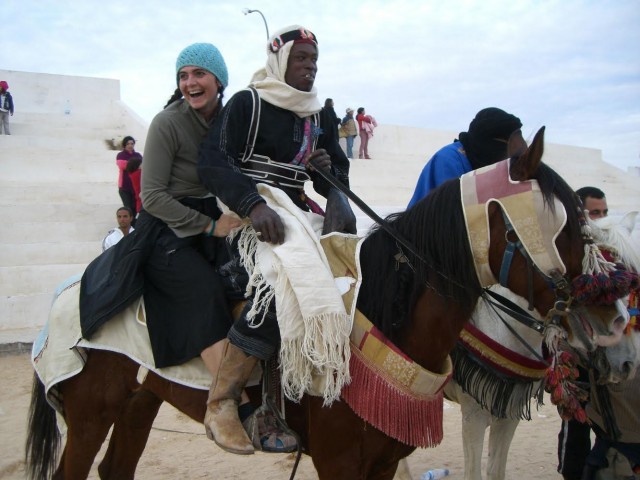
The tangy smell of the sinewy rider and his valiant steed lingered on my skin long after he’d gently replaced my feet on the sand. When I closed my eyes that night, under dark, desert skies, I could still feel his hard back against my breasts and his warm hand wrapped around mine, pressed to his belt, lest I fall.
I dreamt of hoof beats between drum beats and our mingled laughter as we’d raced toward the horizon.
Photo credits: trevor kittelty, all other photos courtesy of the author and may not be used without permission.